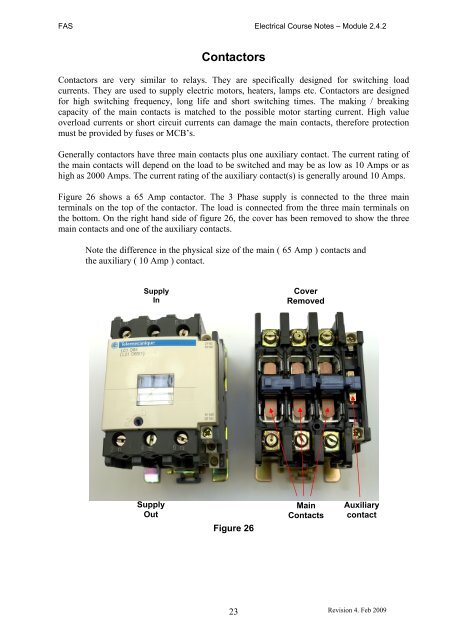Trade of Electrician Motor Control COURSE NOTES - eCollege
Trade of Electrician Motor Control COURSE NOTES - eCollege
Trade of Electrician Motor Control COURSE NOTES - eCollege
You also want an ePaper? Increase the reach of your titles
YUMPU automatically turns print PDFs into web optimized ePapers that Google loves.
FAS Electrical Course Notes – Module 2.4.2<br />
Contactors<br />
Contactors are very similar to relays. They are specifically designed for switching load<br />
currents. They are used to supply electric motors, heaters, lamps etc. Contactors are designed<br />
for high switching frequency, long life and short switching times. The making / breaking<br />
capacity <strong>of</strong> the main contacts is matched to the possible motor starting current. High value<br />
overload currents or short circuit currents can damage the main contacts, therefore protection<br />
must be provided by fuses or MCB’s.<br />
Generally contactors have three main contacts plus one auxiliary contact. The current rating <strong>of</strong><br />
the main contacts will depend on the load to be switched and may be as low as 10 Amps or as<br />
high as 2000 Amps. The current rating <strong>of</strong> the auxiliary contact(s) is generally around 10 Amps.<br />
Figure 26 shows a 65 Amp contactor. The 3 Phase supply is connected to the three main<br />
terminals on the top <strong>of</strong> the contactor. The load is connected from the three main terminals on<br />
the bottom. On the right hand side <strong>of</strong> figure 26, the cover has been removed to show the three<br />
main contacts and one <strong>of</strong> the auxiliary contacts.<br />
Note the difference in the physical size <strong>of</strong> the main ( 65 Amp ) contacts and<br />
the auxiliary ( 10 Amp ) contact.<br />
Supply<br />
In<br />
Supply<br />
Out<br />
Figure 26<br />
23<br />
Cover<br />
Removed<br />
Main<br />
Contacts<br />
Auxiliary<br />
contact<br />
Revision 4. Feb 2009

















